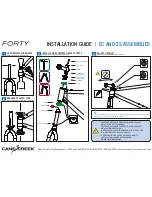
Operation Guide > PowerSafe
®
PV Bloc <
2
Specifi c Abilities
The speci
fi
c abilities of this type of battery for renewable energy applications are as follows.
•
Cycling
(one “cycle” consists of a discharge, of any depth, followed by a recharge)
•
Cycling in state of discharge
•
Low rate of self-discharge
•
No addition of water required during service life
PowerSafe
®
PV Blocs are designed for applications where the battery must undergo repeated cycling with daily depths
of discharge of up to 35% of capacity C
120
(such as rural settlements, communications systems and lighting systems etc.).
Cell Design
The PowerSafe
®
PV Bloc cells consist of:
• Positive
fl
at plates with Lead-Calcium-Tin alloy
• Low resistance mircoporous separator
• Electrolyte immobilised as a gel
• Pressure Relief Valve - One way valve with intergral
fl
ame arrestor
• Polypropylen lid and container
• Automotive type terminals
Features & Benefi ts
• Excellent deep discharge recovery and cyclability
• Up to 800 Cycles to 50% depth of discharge
• Vertical installation only
• No topping up required
• Minimal mainenance required
Capacity
Capacity is the number of Ah a battery can supply for a well-defi ned current and an end of discharge voltage.
Capacity varies with the discharge time, discharge rate and temperature.
Example Capacities for 12PVB70 bloc are as follows:
Discharge time
10 h
120h
End voltage
1.80Vpc
1.85Vpc
Temperature
20°C
25°C
Capacity
57Ah
70Ah
Safety precautions
Batteries give off explosive gasses. They are
fi
lled with dilute sulphuric acid, which is very corrosive. When working with sulphuric
acid, always wear protective clothing and glasses. Exposed metal parts of the battery always carry a voltage and are electrically live
(risk of short circuits). Avoid electrostatic charge. The protective measures according to EN 50272-2 must be observed.
Care for your safety
No smoking
no naked
fl
ames,
no sparks
Shield eyes
Note operating
instructions
Electrical hazard
Danger
Recycle scrap
batteries.
Contains lead.
Electrolyte is
corrosive, in case
of broken
containers/lids
Clean all acid splash
in eyes or on skin
with lot of clear water.
Then visit a doctor.
Acid on clothing is to
be washed with water. .
Risk of explosion or
fi
re,
avoid any short circuit.
Metallic parts under
voltage on the battery : do
not lean tools or items on
top of the battery.
Handling
PV Bloc batteries are supplied in a fully
charged state and must be unpacked
carefully to avoid short-circuit between
terminals of opposite polarity. The cells
are heavy and must be lifted with appro-
priate equipment.
Keep Flames Away
In the case of an accidental overcharge,
a
fl
ammable gas may be emitted from
the safety valve.
Discharge any possible static electricity
from clothes by touching an earth-
connected part.
Tools
Use tools with insulated handles.
Do not place or drop metal objects onto the
battery.
Remove rings, wristwatch and metal articles
of clothing that might come into contact with
the battery terminals.
Warranty
Any of the following actions will invalidate the warranty - Non-adherence to the Installation, Operating and Maintenance instructions. Repairs carried out with
non-approved spare parts. Application of additives to the electrolyte. Unauthorised interference with the battery.


























